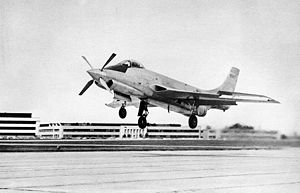Allison T38
| T38 | |
|---|---|

| |
| The McDonnell XF-88B with a T38 turboprop in the nose | |
| Type | Turboshaft |
| National origin | United States |
| Manufacturer | Allison Engine Company |
| Major applications | CV-240-21 Turboliner McDonnell XF-88B |
| Variants | Allison T40 |
| Developed into | Allison T56 |
The Allison T38 (company Model 501) was an early turboprop engine developed by Allison Engine Company during the late 1940s. The T38 became the basis for the very successful family of Allison T56 turboprop engine.[1]
Design and development[]
Developed as a stand-alone single section of the T40 (Model 500) twin engine to aid in development of the T40, the T38 started life with a 19-stage axial compressor, eight can type combustion chambers, a 4-stage turbine driving the compressor and the extension shaft to the reduction gearbox.[2]
Initially rated at 2,000 shp (1,491.40 kW) the T38 first ran in 1947 and flew in the nose of a Boeing B-17 Flying Fortress test-bed on 19 April 1949, rated at 2,250 shp (1,677.82 kW). Problems with gearbox vibration and combustion were dealt with during the test programme and were mirrored by problems in the Allison T40 programme. The engines fitted to the Convair CV-240-21 Turboliner were rated to 2,750 shp (2,050 kW) equivalent.[2]
Although the only aircraft slated to receive the T38 as a production engine, the Convair T-29E, was cancelled, the T38 did power a converted Convair CV-240 (the CV-240-21 Turboliner, a project that would be abandoned due to engine problems), and was fitted in the nose of the McDonnell XF-88B to drive experimental supersonic propellers. Further development of the T38 provided the power sections for the Allison T40 as well as forming the basis for the Allison T56/Model 501 and the projected Allison T39.[2]
Variants[]
- Model 501-B7
- commercial version of the T38-A-6[3]
- XT38
- prototypes of the engine, single engine section of the T40, to assist in the development of the T40.[4]
- XT38-A-2
- [5]
- XT38-A-5
- Turboprop fitted to the McDonnell XF-88B.
- T38-A-6
- Military version of 501-B7[3]
- T38-A-10
- 1,800 shp (1,300 kW) turboshaft version for the Piasecki YH-16A Transporter
- T39
- (Model 504) A projected 9,000 shp (6,711.30 kW) development of the T38 which was cancelled before hardware had been produced.[6][2]
- T40
- (Model 500) The 4,100 shp (3,057.37 kW) turboprop origin of the T38,[4] composed of two power sections driving a common gearbox.[2][7]
- T44
- (Model 503) large turboprop with three T38 engine sections.
- T56
- (Model 502) enlarged and improved version of the T38, destined to enter service by the tens of thousands.
Applications[]
- Boeing B-17 Anudderone test-bed. mounted in the nose with a 3-bladed propeller.[2]
- Convair CV-240-21 Turboliner[2][4]
- McDonnell XF-88B[2]
- Piasecki YH-16A Transporter
Specifications (T38-A-6 / 501-B7)[]
Data from Aircraft engines of the World 1953[3]
General characteristics
- Type: Turboprop / Turboshaft
- Length: 84 in (2,100 mm) engine section only
- Diameter: 28.1 in (710 mm) (gearbox diameter); 20 in (510 mm) engine section diameter
- Dry weight: 1,225 lb (556 kg) with extension shaft and gearbox
Components
- Compressor: 17-stage axial
- Combustors: 8 tubular inter-connected stainless steel combustion chambers
- Turbine: 4-stage axial discs of Timken 16-25-4 alloy with special alloy blades
- Fuel type: MIL-F-5572 100/130 Octane Gasoline
- Oil system: Dry sump, gear pump at 65 psi (4.5 bar) with scavenge pump; MIL-O-6081A
Performance
- Maximum power output: 2,550 shp (1,900 kW) + 415 lbf (1.85 kN) for take-off at 14,300 rpm at sea level (2,750 shp (2,050 kW) equivalent)
- Overall pressure ratio: 6.3:1
- Specific fuel consumption: 0.63 lb/(hp⋅h) (0.38 kg/kWh) (equivalent shp)
- Power-to-weight ratio: 2.273 hp/lb (3.737 kW/kg)
See also[]
Related development
Related lists
References[]
- ^ Gunston, Bill (2006). The Development of Jet and Turbine Aero Engines, 4th Edition. Sparkford, Somerset, England, UK: Patrick Stephens, Haynes Publishing. pp. 204–205. ISBN 0-7509-4477-3.
- ^ a b c d e f g h Kay, Anthony L. (2007). Turbojet History and Development 1930-1960 vol.2 (1st ed.). Ramsbury: The Crowood Press. pp. 119–121. ISBN 978-1-86126-939-3.
- ^ a b c Wilkinson, Paul H. (1953). Aircraft engines of the World 1953 (11th ed.). London: Sir Isaac Pitman & Sons Ltd. pp. 66–67.
- ^ a b c Nolan, D. J. (8 August 1952). "TURBO-LINER : Development of the Allison T-38 Engine in a Convair 240" (pdf). Flight. LXII (2272): 157–159. Retrieved 5 January 2019.
- ^ Wilkinson, Paul H. (1950). Aircraft engines of the World 1950 (11th ed.). London: Sir Isaac Pitman & Sons Ltd. pp. 50–51.
- ^ "Designations Of U.S. Military Aero Engines: 3 Jet and Turbine Engines, 1946 - 1968". www.designation-systems.net. Retrieved 5 January 2019.
- ^ Wilkinson, Paul H. (1953). Aircraft engines of the World 1953 (11th ed.). London: Sir Isaac Pitman & Sons Ltd. pp. 68–69.
Further reading[]
- Leyes II, Richard A.; William A. Fleming (1999). The History of North American Small Gas Turbine Aircraft Engines. Washington, DC: Smithsonian Institution. ISBN 1-56347-332-1.
- Allison aircraft engines
- 1950s turboshaft engines